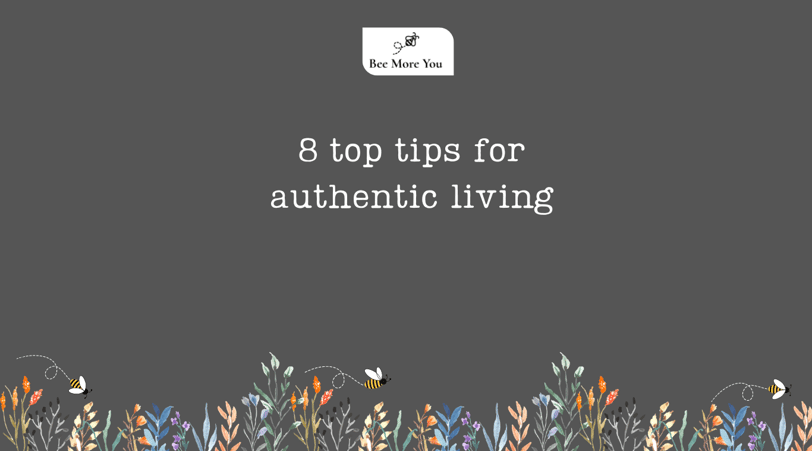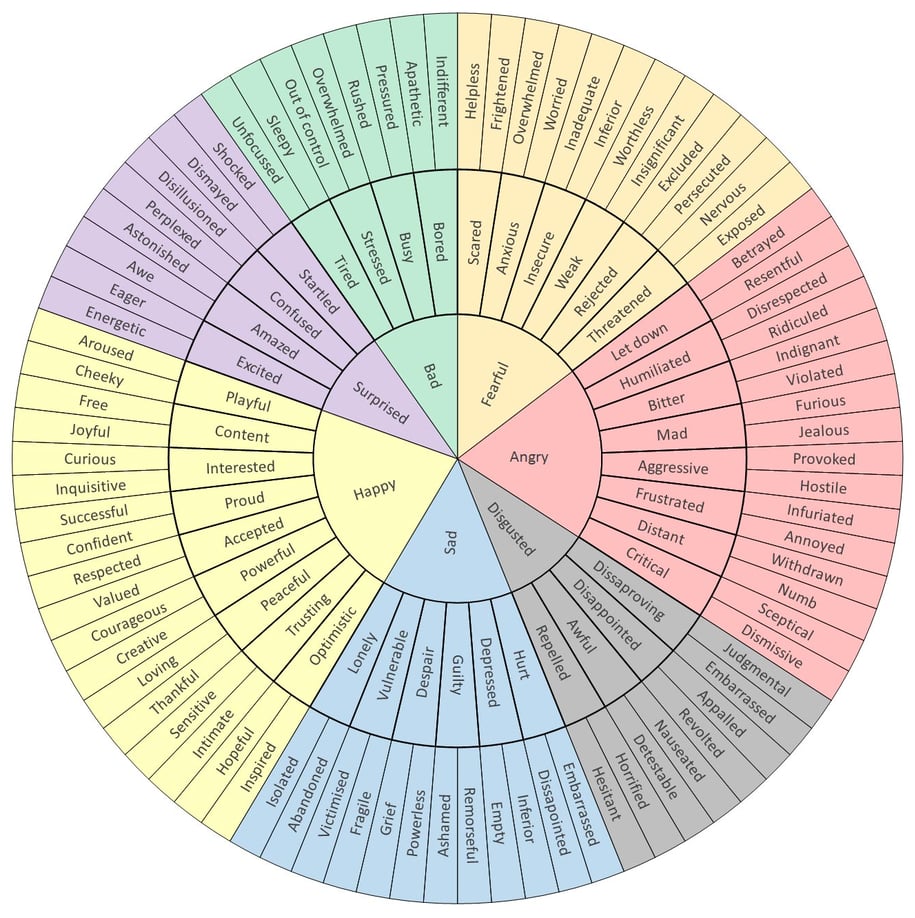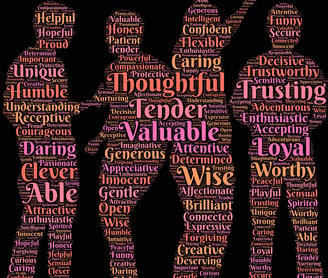8 top tips to start living more authentically
8 key strategies to start living more authentically so you can Bee More You.


8 Tips for authentic living
In part one of this series, we explored authenticity and it's impact on letting you bee more you. We explored what authenticity is, why it matters for wellbeing, some of the psychology behind wellbeing, and why it can be hard to live authentically.
In this second part we are going to share the 8 strategies we think make the most difference when trying to bee more you. Like any new practice, this will take time to build. Be kind to yourself and take it one step at a time. The most fundamental thing is to really get to know yourself. As we have seen in part one, this is not always as obvious as we think it should be. Begin by taking time to slow down and really get to know yourself. Ask yourself what you really want in any given situation. Listen and notice your answers. Start to try some of the different strategies here and see what works for you.
1 - Disconnect to reconnect


To know ourselves and be in tune with our body, thoughts, and feelings, we need to practice staying fully present. This can be a challenge in our busy, always connected lives.
Mindfulness can really help with this. If mindfulness gives you the horrors and conjures up images of chanting hippies with singing bowls and incense, it might help to know there are many ways of being mindful!
You can choose any that resonate with you, and mix them up whenever you need a change
Journaling to prompts (Ronie loves the five minutes in the morning cards)
Journaling as a freewriting exercise
Using a program like 750 words
Meditating by yourself
Listening to a guided meditation
Using an app such as balance, calm, or headspace
Going for a walk-in nature, alone, without music
Having a mindful coffee in the morning - being fully present, enjoying the feel of the hot cup in your hand, noticing the steam rising, smelling the coffee, enjoying and savouring the taste.
2 - Define and embrace your strengths


What are you good at? What comes naturally to you? The chances are strengths for you are things that get you to a happy place and a flow state. When you work with your strengths it feels fun and easy and energises you.
Taking some time to identify your strengths, and allowing yourself space to build on and work with them will help you be happier, more productive, and more energised in your work and home lives.
And guess what? A happier, energised you, doing things you love, allows you to show up as your authentically awesome and inspiring self.
There are several great strength finder tests out there if you don’t yet know your strengths. Some are free, others ask for payment to access a detailed report.
3 - Notice and name emotions


We can often be quite bad at being able to name our emotions. We are used to damping them down with food, drink, drugs, or mindless scrolling on the Internet. It can be really hard to name your feelings. Yet feelings can be a really good indicator as to whether a proposed course of action is authentic. If this is you, then a feelings wheel like this one from Geoffery Roberts might be helpful.
Save a copy to your phone, print it out and put it in your office or on the fridge. When you notice yourself feeling something, check out the feelings wheel and see if you can narrow it down to a more specific feeling. Each time you practice this skill it becomes easier for you to interpret the signals your body is sending you so you can use this information to guide your actions.
4 - Explore your values


What are your core values? What matters to you as a person? This deceptively simple question really can be key to unlocking a massive amount of insight into what matters to you as a person. It is also the number one thing that makes a difference to living authentically. Perhaps it’s no surprise that it often comes up in my coaching sessions with clients!
When you know your values, and you are faced with a decision such as trying to decide between two options, or choosing a new path to take, you can ask - does this fit with my values? When we live in line with our values, we can’t help but live authentically.
There are a lot of different value lists out there, such as the one at James Clear. See if you can narrow it down to just five. This is something that can be useful to explore in coaching, and you can book a one-off values session with me to do this (£97 for 90 minutes).
Clients like Becky and Kate found it a key element of their decision making for work choices, family life, and wellbeing planning. The simple question of considering a choice in light of “how does this fit my values” made it much easier for them to make decisions and move forward authentically.
If this is of interest, you can book a free no-pressure insight call here to find out more.
5 - What's your why?


Why are you really making the decisions you are making? What's driving you? Is it really your choice - or the one you think you should be making?
We are all a mix. No one does everything for internal reasons, and no one does everything for external reasons. External sources such as family groups, societal norms, and workplace culture all drive our behaviours. Alongside this sit our own internal desires and interests, but sometimes it can be hard to tell what is behind our goals.
For example, a recent client came to coaching because they wanted to get a promotion into a newly vacant role. When we started exploring the topic of work, they realised that they didn’t much like the work they were currently doing since being promoted to manager. They missed the hands-on elements of the job and instead spent all their time in meetings and managing people. Coaching allowed them to realise that the promotion they thought they wanted would have just compounded that issue and they would have even less time doing the things they really enjoyed. Promotion wasn’t their own personal goal; it was what they thought they should do.
Self-talk can provide us with some great clues if we pay attention - anytime we hear the words "should", or "need" it can be an indicator that there are external influences at play here. Sometimes life sucks and we have to do stuff anyway, but if you can catch your "shoulds" and check in with yourself, it becomes easier to start to recognise what you really want in a situation.
6 - Set boundaries


One of the most common reasons for not feeling authentic, is not being able to say no!
If you are a habitual people pleaser, someone with caring responsibilities, or someone who prefers to avoid conflict, you might find your instinctive response to a request is yes. If you have ever kicked yourself for agreeing to something you really didn’t want to do, you will know how uncomfortable this can be.
As well as now having to do something you didn’t want to do, the hidden cost of saying yes is that you are saying no to other ways to spend your time. These may have been ways that move you closer to living authentically and supporting your wellbeing.
7 - Pursue your passions
This was a common theme for Michelle when she came to coaching. She often found herself agreeing to take on more work, and not speaking up for what she really wanted at home to keep home life running smoothly. After coaching she reported that she felt able to have ‘courageous conversations with my boss and set boundaries at home. I have renegotiated my workload and selfcare is important as my commitment to others’. Michelle did this by taking multiple small steps. This let her build her confidence and stretch her comfort zone until she was finally living a more authentic life because of having the courage to set boundaries.
Setting boundaries can feel scary if we are not used to doing it. This article from the Science of People has some great tips to help you identify, set and communicate boundaries


When was the last time you had fun? Or lost track of time because you were engrossed in a hobby? Too often our busy lives leave little time for true fun.
True fun is a concept written about by Catherine Price in her book “The power of fun: how to feel alive again” and is that moment when playfulness, connection and flow come together. She describes it as this….
“True fun (…) is the feeling of being fully present and engaged, free from self-criticism and judgement. It is the thrill of losing ourselves in what we’re doing and not caring about the outcome. It is laugher. It is playful rebellion. It is euphoric connection. It is the bliss that comes from letting go. When we are truly having fun, we are not lonely. We are not anxious or stressed. We are not consumed by self-doubt or existential malaise. There is a reason that our moments of True Fun stand out in our memories: True Fun makes us feel alive”
Spending regular time doing things that you are passionate about brings joy, contentment, and a sense of fulfillment. Do it regularly and not only will you feel happier, healthier, and less stressed, but you will automatically be living authentically.
I’ve had some awesome moments of True Fun in my life - learning to roller skate and play roller derby definitely counts, as does the summer I agreed to go on a cycling holiday across France when I could barely cycle. I’ve had True Fun singing with gusto at karaoke, and sitting on a beach with an ice cream having played hooky from work to make the most of a rare day of sunshine in Orkney.
Writing this is a good reminder to me - make some time for some more True Fun. I’ve fallen into the trap of being busy, and moments like these are less frequent than I’d like.
If you want to have some more True Fun start by thinking about things that you love to do. Maybe they are things you haven’t done for a while, or perhaps they are new hobbies you have always wanted to try. Then look at your calendar. Block in some recurring time for you to start to explore this passion. Set clear boundaries around your time. This is a non-negotiable appointment for you to do something just for you. When your time arrives forget about everything else. This is your time. Immerse yourself in the experience. Switch off that nagging voice of guilt, connect with what you are doing and give yourself permission to enjoy this time.
8 - Build your social support system


“You are the average of the people you spend time with” Jim Rohn
This is perhaps a little simplistic, but it has some truth to it. The people you spend time with are the people who influence you the most. When you have a genuine connection with people you feel safe and like you can show up as your authentic self.
Abraham Maslow was a psychologist who came up with the concept of the hierarchy of needs. This theory underpins a lot of our understanding of how human’s function and flourish in the world.
Maslow argued that human needs build on each other. You can only focus on the higher levels once the base levels are met. When we look at this hierarchy though we can see a role for other people in all levels except perhaps the very top. Being part of a community, feeling like we belong is an innate human need. So it makes sense that the people that you surround yourself with will have a strong influence on how you are able to show up in your life. If you are going to chose people to be with, why not focus on those that let you be your whole self?
Sadly, in today’s modern world it can be very hard to find people to be social with. Stephen reflected on that in this blog post. I know several people who report feeling quite lonely or isolated despite the illusion we have of 24-hour global connections via the internet. Increasing our social wellbeing pillar is definitely a work in progress for us, but here are some suggestions for you to consider.
Volunteer
Join a special interest network or group locally
Start a book club
Reach out to friends and family and take time to stay in touch
Show your appreciation to deepen existing relationships
Show up as your authentic self to build new connections
Keep communication channels open
Be available for friends when they need you
In conclusion -
So there we have it - 8 tips for being more authentic in your life. The most important thing to remember is that authenticity is a practice. It takes time to shift your behaviours, especially habitual ones. Be kind to yourself, practice self-compassion and embrace the messy practice of learning a new way to be. It will feel uncomfortable at times, but that is where growth happens. Take small daily actions and you will gradually begin to feel more comfortable showing up as your whole, unapologetic, kick-ass self.
If you would like some support with this, you can join our newsletter. We send out regular weekly email newsletters with tips and updates on our latest blog posts, courses, and coaching programs.
You can also schedule a free insight call if you would like to learn more about our coaching services.


